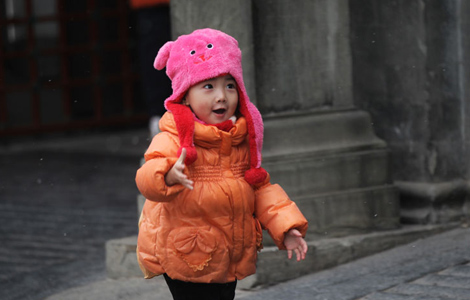China's ban on US chicken could cost millions
Updated: 2015-01-14 11:50
By Jack Freifelder in New York(China Daily USA)
|
||||||||
China's ban on the import of poultry and eggs from the United States in response to the presence of avian flu could cost the US poultry trade many millions of dollars, according to an industry executive.
Jim Sumner, president of the USA Poultry and Egg Export Council (USAPEEC), said the ban that China put in place on Jan 8 will affect shipments of chicken paws.
"Our major poultry exports to China are in the form of paws and wingtips, and China is one of the only primary export markets we have for paws," Sumner told China Daily on Tuesday. "Unfortunately, there are few other markets for this product, which means that it will probably go for rendering instead of for export.
"Paws have commanded maybe upwards of 90 cents a pound in the China market, and if they don't get sold to China and they go to rendering, they may be providing 3 or 4 cents a pound," he said. "This is going to cost our industry many millions of dollars."
China's Ministry of Agriculture and the country's General Administration for Quality Supervision, Inspection and Quarantine issued a joint announcement detailing the ban, which also applies to breeding stock, which includes live chicks and hatching eggs.
Last month, a highly pathogenic strain of H5N8 avian influenza was discovered among wild birds and in a "backyard flock" of guinea hens and chickens in Oregon. The US Department of Agriculture also confirmed another strain of avian flu (H5N2) that was detected in two separate cases in California and Washington state.
Government officials have said that these varieties of bird-flu viruses have not been found in any commercial flocks in the US, adding that detection in noncommercial birds represents "no immediate public health concern".
The H5N8 strain has also appeared in China, Japan and South Korea, and more recently in the United Kingdom and Canada.
Agriculture officials have warned citizens that the biggest risk to other birds in the area comes from migratory bird populations, but the USDA has said it plans to increase the amount of testing where the avian flu strains were initially found.
Most bird flu viruses do not infect humans. But another strain, H5N1, which severely affected poultry in Asia, became a worldwide concern because in 2003 it was more easily spread among humans.

US poultry exports to China reached $272 million in the first 11 months of 2014, according to data from the USAPEEC. USDA data shows that China was the sixth-largest importer of US chicken meat and the second-largest import destination for US turkey.
The bulk of US chicken production is located in the Southeastern United States, Sumner said, including states like Georgia, Arkansas and Alabama. Minnesota and North Carolina figure most prominently in the grand scheme of the country's turkey production.
He also said an important aspect in the recent detection of avian flu is that the birds in question are not part of any commercial operations. "These are backyard flocks, and that's the key point here," Sumner said.
China's decision to restrict imports from the US comes on the heels of similar action from a number of other countries around the world.
Reuters contributed to this story.
jackfreifelder@chinadailyusa.com
(China Daily USA 01/14/2015 page2)

 Mental illness no handicap to Nanjing artists
Mental illness no handicap to Nanjing artists
 Kashgar's diversity of cultures
Kashgar's diversity of cultures
 Best wedding snaps in 2014
Best wedding snaps in 2014
 Fancy sportscars premiere at Detroit auto show
Fancy sportscars premiere at Detroit auto show
 Looking hot in the cold
Looking hot in the cold
 Beijing sees first winter snow amid heavy smog
Beijing sees first winter snow amid heavy smog
 Elderly swimmers see health benefits in freezing water
Elderly swimmers see health benefits in freezing water
 Girl uses nose to run online store
Girl uses nose to run online store
Most Viewed
Editor's Picks

|

|

|

|

|

|
Today's Top News
Chinese tourists boost travel to Los Angeles
Turkey to help in foiling suspects from Xinjiang
Japan unveils record defense budget
HK halts investment program
China unifies pension system
Lingerie not focus of Victoria's Secret in China
China's ban on US chicken could cost millions
SelectUSA round 2 gears up
US Weekly

|

|







